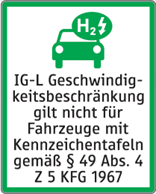Speed
Speed in Road Traffic – Safe and Adjusted Driving.
The right speed is crucial for your safety and that of all road users.
On this page, you will find comprehensive information about speed limits, legal regulations, and ASFINAG's measures regarding speed restrictions on Austria's motorways and expressways. Learn how modern technology, traffic management, and targeted controls help prevent accidents and optimize traffic flow.
All questions - Speed
In Austria, the maximum speed on motorways and expressways is 130 km/h (for motorcycles and vehicles up to 3.5 t maximum permissible gross weight). Additional speed limits are only imposed when required by legal regulations (e.g., environmental protection, protection of humans and animals) or for safety reasons.
On hazardous road sections, speed limits of 100 km/h or 80 km/h are necessary – for example, on very tight curves, where there is no emergency lane, or in areas with a history of frequent accidents.
Speed limits are only signposted or displayed by ASFINAG when they are necessary and appropriate, when ordered by a competent authority, or when urgent events require them (§ 44b StVO). The Austrian Road Traffic Act (StVO) specifies which traffic signs (indicators) must be used and which rules must be followed.
Criteria for additional speed limits may include:
- Traffic volume (number of vehicles)
- Weather conditions (wet roads, fog, precipitation, etc.)
- Hazards (accidents, traffic jams, smoke near the roadway, etc.)
Often, speed limits are automatically set, as numerous sensors collect traffic and environmental data along motorways and expressways.
Note: Speed and driving behavior are monitored by the police, not by ASFINAG.
Changing speed limits are preventive measures to avoid traffic jams and to dissolve vehicle clusters.
Variable speed limits are activated automatically during specific traffic situations to prevent congestion and break up vehicle clusters (groups of vehicles driving closely together). For example, our automatic detection system can identify several vehicles driving closely together as an impending traffic jam and trigger a variable speed limit (e.g., 100–80–100 or 80–60–80).
In the actual traffic jam area, the speed is not further restricted; instead, the message "STAU" (traffic jam) is displayed on electronic signs.
For conducting speed measurements and penalizing speed violations, the executive authority (police) is solely responsible. As road operators, we only perform supportive tasks, such as installing traffic signs or providing warnings.
ASFINAG does not provide third parties with any information about past settings related to speed measurements.
If you have received an anonymous penalty notice due to a speed violation, please contact the issuing authority directly
For violations of the Road Traffic Act (StVO), please contact the police. ASFINAG is not authorized to penalize such violations or conduct traffic controls – and does not do so.
Such violations (administrative offenses) include, for example, driving under the influence of drugs, failing to maintain a safe distance (tailgating), overtaking on the right lane, or ignoring driving bans or the obligation to drive on the right.
A speed limit with the additional text "IG-L" is based on the Immission Control Act – Air. This act, abbreviated as IG-L, allows speed limits to be imposed in certain areas to protect the environment. The goal is to reduce pollutant emissions, particularly fine particulate matter (PM10) and nitrogen oxides (NO2).
The Immission Control Act – Air (IG-L) allows exceptions to speed limits under certain conditions:
- This exception applies only to vehicles with pure electric drive or hydrogen fuel cell technology, but not to plug-in hybrid electric vehicles.
- The exception can only be claimed by vehicles with license plates featuring green lettering (§ 49 Abs. 4 Z 5 KFG 1967).
- It is only valid on road sections where signs explicitly indicate the exception (see example image).
A traffic management system (TMS) is a technical system that dynamically controls and manages road traffic to enhance traffic safety, prevent congestion, and optimize traffic flow.
TMS briefly explained:
- Components: Variable message signs, traffic signal systems, sensors, cameras, detectors.
- Function: Displays, for example, variable speed limits, warnings (e.g., for fog or icy conditions), lane closures, or diversion recommendations.
- Locations of use: Commonly found on motorways and expressways, in tunnels, or on heavily frequented road sections.
Speed limits and congestion warnings on traffic management systems (TMS) are used to ensure traffic safety and flow. They can be triggered by cameras or sensors detecting high vehicle density or adverse weather conditions, such as rain or snow, on the upcoming stretch of road. They may also be activated by events such as construction work, accidents, or specific hazardous situations, for instance, in tunnels. These measures are based on automated systems and legal regulations.



